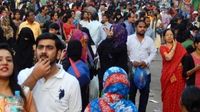India’s labor market is showing fresh signs of resilience as the country’s unemployment rate dropped to 5.2% in July 2025, the lowest in three months, according to newly released government data. This decline, highlighted in the Periodic Labour Force Survey (PLFS) by the Ministry of Statistics and Programme Implementation (MoSPI), comes as rural hiring picked up ahead of the festival season and agricultural activity ramped up, providing a much-needed boost to job seekers across the country.
According to Economic Times, the overall national unemployment rate fell from 5.6% in June to 5.2% in July. The improvement was particularly pronounced in rural areas, where unemployment dropped to 4.4% from 4.9% the previous month. Among rural males, the rate fell to 4.6% from 5.1%, and among rural females, it dropped to 3.9% from 4.4%. The story in urban India, however, was a touch more complex—urban unemployment ticked up slightly to 7.2% in July from 7.1% in June, with urban male unemployment rising to 6.6% from 6.4%, while urban female unemployment eased to 8.7% from 9.1%.
The PLFS, as reported by PTI, also noted that joblessness among men nationwide stood at 5.3%, while among women, it was marginally lower at 5.1%. For young people aged 15 to 29, there was a mixed picture: youth unemployment declined to 14.9% in July from 15.3% in June. Yet, in urban areas, youth unemployment crept up to 19% from 18.8%, while rural youth saw a sharper drop to 13% from 13.8%. These figures reflect the activity status of individuals based on the week preceding the survey, capturing those who were either working or actively seeking work.
Labour force participation is another crucial metric that has shown improvement. The Labour Force Participation Rate (LFPR)—the share of the population either working or seeking work—rose to 54.9% in July from 54.2% in June, according to MoSPI’s latest bulletin. Male participation held steady at 77.1%, while female participation increased to 33.3% from 32%. In rural areas, the LFPR for women jumped to 36.9% from 35.2%, suggesting more women are entering the workforce, possibly drawn by seasonal agricultural opportunities and festival-related employment. Urban LFPR also edged up, with male participation at 75.1% (up from 75%) and female participation at 25.8% (up from 25.2%).
As Business Today explained, the Worker Population Ratio (WPR)—the proportion of employed people among the total population—also saw gains. In rural areas, the WPR for individuals aged 15 and above rose to 54.4% in July from 53.3% in June. For urban residents, it stood at 47% in July. Nationally, the WPR improved to 52% from 51.2%. These numbers, while incremental, point to a labor market that is slowly but steadily absorbing more workers.
Sectoral trends remain clear and consistent. Agriculture continues to be the backbone of rural employment, while the services sector dominates urban job creation. According to Business Today, self-employment is the norm in rural India, with 55.3% of rural men and a striking 71.6% of rural women engaged in self-driven enterprises. In contrast, regular wage and salaried jobs are more common in urban areas, with 47.5% of urban men and 55.1% of urban women holding such positions. These patterns reflect the ongoing urban-rural divide in the nature of employment opportunities across India.
Behind these statistics lies a massive data collection effort. The revamped PLFS methodology, introduced in January 2025, now provides monthly, quarterly, and annual estimates for both rural and urban India. In July alone, 7,519 first-stage sampling units were surveyed, covering a whopping 89,505 households—49,355 in rural areas and 40,150 in urban areas. In total, 379,222 individuals participated, with 216,832 from rural areas and 162,390 from urban centers, according to PTI. For the April–June quarter, over 134,000 households and 570,000 individuals were surveyed nationwide. This high-frequency, granular data is seen as critical for policymakers aiming to design targeted interventions for inclusive economic growth.
The positive labor market trends are set against a backdrop of broader economic optimism. As reported by Reuters, S&P Global Ratings on August 14, 2025, upgraded India’s long-term sovereign credit rating to 'BBB' from 'BBB-', the first such upgrade in 18 years. The ratings agency cited strong economic growth, improved monetary policy credibility, and sustained fiscal consolidation as key factors. India’s real GDP growth averaged a robust 8.8% between fiscal years 2022 and 2024—the highest in the Asia-Pacific region—and is projected to grow at 6.8% annually over the next three years. These macroeconomic fundamentals are seen as providing a solid foundation for continued job creation and labor market stability.
Government policy is also playing a role. India’s federal government has announced plans to cut its goods and services tax by October, a move aimed at supporting local manufacturing and job creation amid rising trade tensions with the United States. The hope is that a lower tax burden will stimulate domestic production and, in turn, generate more employment opportunities, especially in sectors vulnerable to international competition.
Still, challenges remain. While rural areas are seeing notable gains, urban unemployment—especially among youth—remains stubbornly high. The slight uptick in urban joblessness in July, and the persistent gap between male and female labor force participation, highlight ongoing structural issues. Women’s participation, though improving, continues to lag behind men’s by a wide margin. The female Worker Population Ratio stood at 31.6% in the April–June quarter, compared to 73.1% for men, according to Business Today. Bridging this gender gap will require sustained policy attention and cultural change.
Moreover, the nature of employment is evolving. The dominance of self-employment in rural India suggests that many workers may be engaged in low-productivity or informal jobs, which can be precarious and low-paying. In urban areas, the prevalence of regular wage and salaried positions is a positive sign, but the overall employment landscape remains deeply segmented by geography, gender, and sector.
As India navigates these complexities, the latest data offers both reassurance and a reminder of the work ahead. The drop in unemployment and the rise in labor force participation are encouraging, but the unevenness across regions and demographics calls for nuanced, targeted policy responses. With the government pledging reforms and the economy enjoying renewed international confidence, the coming months will test whether these early gains can be sustained and broadened to benefit all Indians.
For now, the numbers tell a story of cautious optimism—a labor market on the mend, driven by rural dynamism and underpinned by a growing economy, but still facing the perennial challenge of delivering good jobs for all.

